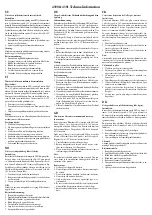
PDF: 4749051511/Source: 7788125767
Aptina reserves the right to change products or specifications without notice.
MT9T111_DG - Rev. B 9/10 EN
145
©2007 Aptina Imaging Corporation. All rights reserved.
MT9T111: Developer Guide
Appendix B – Demo Board Systems
Preliminary
Appendix B – Demo Board Systems
Three boards are provided to support both parallel and MIPI output:
• Head board
• Demo2 board
• MIPI receiver board
The head board has an MT9T111 sensor and corresponding CRA lens. The parallel port
signals are available through a 26-pin header, and the MIPI port signals are available
through an RJ45 connector. The Demo2 board is the common platform for all Aptina
sensor head boards to interface to PC USB port. The Demo2 board has a USB controller
and an FPGA to convert parallel data outputs to the USB port. The headboard and the
Demo2 board communicate through a two-wire serial interface. Both boards are
powered by the USB interface. Figure 69 shows the block diagram of the head board and
the Demo2 board in parallel data configuration.
Figure 70 on page 146 shows the connection for using the MIPI receiver board between
the head board and the Demo2 board for the MIPI interface. The MIPI receiver connects
to the head board through a RJ45 connector. The MIPI receiver board converts the serial
MIPI data back to parallel data and routes it to the Demo2 board. The MIPI receiver
board needs a separate (+5V) power supply. The external 5V supply should be turned on
before the USB connection.
Figure 69:
Demo Board (Parallel Mode)
Parallel Output
(PIXCLK, FV, LV, D
OUT
[7:0])
Head Board
Demo2 Board
H
e
a
d
e
r
FPGA
PC
running
DevWare
USB
Lens
23
0
RJ45
MT9T111
H
e
a
d
e
r
RJ45
MIPI_TX
MIPI_RX



































